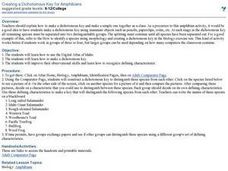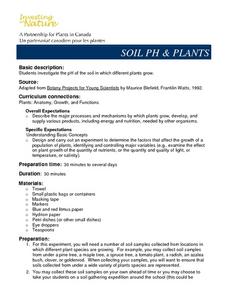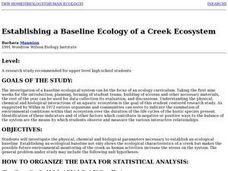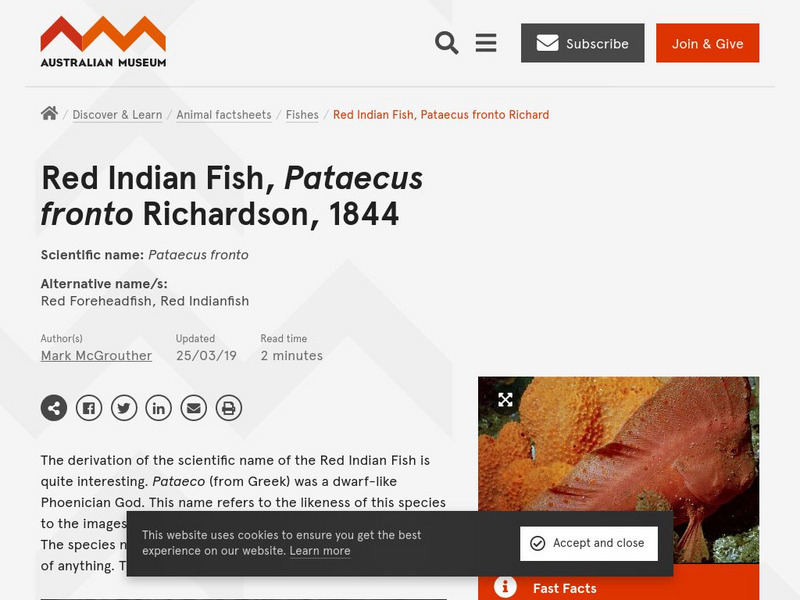Curated OER
Ecology
Learners explore, experience and experiment identifying the human impact on the environment of vegetative differences within the same biome. They assess what causes deserts, rain forests, savannahs, tundras and saguaros and how these...
Curated OER
Exploring the Beach
Students explore the beach. In this marine habitat lesson, students inspect sand grains, design beach profiles, classify marine life, and examine natural beach habitats. Students use spreadsheets to record data from their activities at a...
Curated OER
Forestry and Forestry Products
High school and college learners identify forestry career opportunities. They identify the parts of a tree cross-section and trees based on their leaves and characteristics. Pupils calculate board feet and explain safe methods of...
Curated OER
Creating a Dichotomous Key for Amphibians
Students are introduced to the purpose of dichotomous keys and create one together as a class. In groups, they use a digital atlas to examine the different types of amphibians in Idaho. Using this information, they make their own...
Curated OER
Invasive Mussels
In this ecology worksheet, students study a fact sheet on invasive mussels. They answer 8 short answer questions about it after reading the provided information.
Curated OER
Soil pH & Plants
Students investigate the pH of the soil in which different plants grow. They design and carry out an experiment to determine the factors that affect the growth of a population of plants, identifying and controlling major variables...
Curated OER
Establishing a Baseline Ecology of a Creek Ecosystem
Students investigate the physical, chemical and biological parameters necessary to establish an ecological baseline. Establishing an ecological baseline not only shows the ecological characteristics of a creek but makes the possible...
Curated OER
Discover a Pond Food Web
Students study the biodiversity of animal life in a pond. They investigate the interdependence between pond organisms by completing a pond dipping activity and completing a checklist.
Curated OER
Does the Introduction of Pesticides and Fertilizers Alter an Aquatic Ecosystem?
Young scholars conduct an experiment using a small sample from a local water source. They introduce fertilizers and pesticides, separately, and carefully examine the results in their simulated aquatic ecosystem.
Curated OER
Ocean Life
Students examine the fossil remains of ancient sea creatures. They create casts of fossils and identify how sea fossils are formed and consider what type of information fossils can give to scientists.
Curated OER
Jewel of the Earth
Students investigate several organisms, set sticky traps to collect them, and attempt to identify and classify them using a variety of sources. The origins of the organisms are traced and their adaptive features examined.
Curated OER
A Whale Of A Study
Students get some training as a whale biologist, and study about the kinds of things these researchers do and see over the next four months in their study of humpback whales. Some excellent websites are imbedded in this plan.
Curated OER
Digital Wildflower Collection
Students examine biodiversity and classify organisms. In this wildflower activity students go out and take pictures of plants then create a presentation to show the class.
Curated OER
Tree Leaves: Determining the Characteristics They Share in Common
Pupils use their basic knowledge of dendrology concepts and terms. In this tree leaf lesson students divide into groups and determine which characteristics go with what plant.
Curated OER
Critter Characteristics
Young scholars explore the adaptations of deep sea life forms. In this science lesson, students watch a video to observe characteristics which allow for the sea creature to thrive in it's environment. Young scholars determine the...
Curated OER
Wisconsin Birds Lesson Plan
Students, during an outdoor hike, are taught about the different types of birds found in Wisconsin.
Curated OER
DNA the Easy Way (and "Gram Stain" Without the Mess)
Students visualize DNA from cells and explain the basis and importance of the Gram-stain reaction and to perform the KOH test equivalent.
Curated OER
Nothing Goes to Waste Here: Saw Mills in Action
Students examine lumber mills operate and their efficiency. In this saw mill lesson students view a PowerPoint presentation then feel different grades of lumber to see how rough sawn lumber is.
Curated OER
Water Quality Survey: Monitoring the Sustainability of Pigeon Creek
Students research the History of Pigeon Creek (or any watershed in your area). In this environmental science lesson, students conduct field tests such as pH and nitrates. They collect data and compare what they collected with other groups.
Curated OER
Classification of Organisms
In this classification instructional activity, students complete a crossword puzzle with 17 clues about vocabulary pertaining to the classification of organisms.
Curated OER
Classification of Organisms Crossword Answers
In this classification activity, students are provided with the answers to a crossword puzzle which has 17 clues pertaining to classification of organisms vocabulary.
Canadian Museum of Nature
Canadian Museum of Nature: Bird Identification Clues
This resource will help you develop your birdwatching skills. It includes how to find birds, basic tips and how to use field marks such as patterns and colours to help distinguish species.
Australian Museum
Australian Museum: Animal Species: Red Indian Fish, Pataecus Fronto
A description of the Red Indian Fish, which lives only off the coasts of Australia. Description includes identification, habitat, feeding and diet, as well as other characteristics or qualities of the species.
Genome British Columbia
Genome British Columbia: Dna Goes Upc: An Introduction to Dna Barcoding
In recent years, Canadian scientists have been in the forefront of efforts to identify animal species by DNA barcoding. A single gene, cytochrome oxidase I (COI), that is present in all animals is being used to identify each species....























